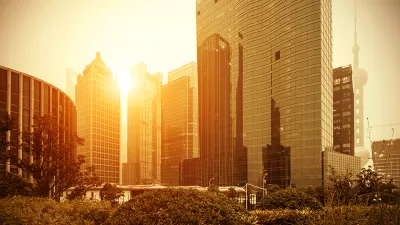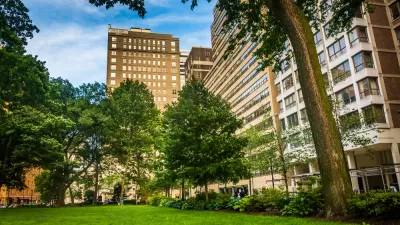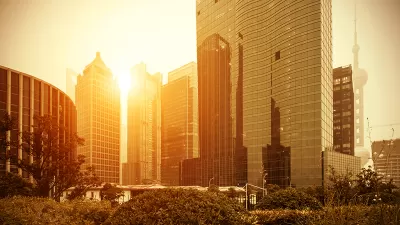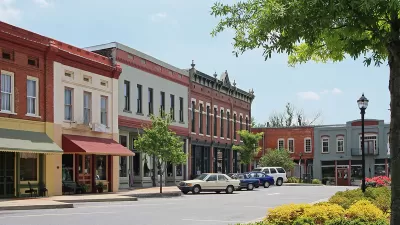Tall buildings and sunlight can amicably coexist- sometimes.

One common argument against tall buildings is that they block out sunlight. One recent headline suggests that tall buildings condemn American cities to a "permanent dusk." But such extreme assertions are pants-on-fire false. How do I know this? I live in midtown Manhattan, which is full of tall buildings. And yet there is plenty of sunlight- not on every street at every minute, but certainly on plenty of streets.

Above is a recent picture of the street where I live- Ninth Avenue in midtown Manhattan (in the high 30s). The buildings on this street are admittedly not 100-story skyscrapers, but the building where I live has fifteen or so stories, and most buildings are at least a few stories. As you can see, there is plenty of sunlight.
Similarly, if you go to Google Street View and look for the Empire State Building (350 5th Avenue), you will see that the street has plenty of sunlight; any shadows cast by this skyscraper affect only the sidewalk right below it- and not even all of the sidewalk.
How come? Probably because Manhattan's avenues are wide enough that any shadows created by buildings are simply overwhelmed by the amount of sun-reflecting pavement. The wider the street, the more sun.
Manhattan's east-west streets are a little narrower than its north-south avenues. However, a look at Google Street View shows that even the streets can be pretty sunny. For example, 19 West 42nd Street seems to have plenty of sunlight, even though that street (unlike Ninth Avenue) has honest-to-goodness skyscrapers. In fact, the major source of shade seems to be not buildings, but the trees in nearby Bryant Park.
Sunlight is at a premium only on the island's narrowest streets. For example, a look at 19 West 44th Street shows far less sunlight, because even a very small shadow can overshadow the street. In other words, height alone doesn't really reduce sunlight as much as height + narrowness: a narrow street full of tall buildings may indeed be very shady, and even a narrow street full of small buildings is not as sun-blasted as Fifth Avenue near the Empire State Building.
One advantage of Manhattan's uneven street grid is that you can go from sunlight to shade and back relatively quickly: if you want sunlight you can walk on a wide avenue, while if you want shade you can walk on a narrow east-west street. On the other hand, there is something of a trade-off between sunlight and pedestrian-friendliness: the sunniest streets tend to be the widest (and thus the most dangerous and dull for pedestrians, in the absence of unusual measures such as medians).
Indeed, the streets of Jacksonville, Florida (where I lived before I moved to New York) were dominated by sun and sky, because of the combination of eight-lane speedways and one-story buildings. (For example, see 9900 San Jose Boulevard in Jacksonville). Nevertheless, any benefit a pedestrian might gain from sunlight in such an environment is arguably outweighed by the ever-present danger of speeding cars and the great blight of dullness.

Trump Administration Could Effectively End Housing Voucher Program
Federal officials are eyeing major cuts to the Section 8 program that helps millions of low-income households pay rent.

Planetizen Federal Action Tracker
A weekly monitor of how Trump’s orders and actions are impacting planners and planning in America.

Ken Jennings Launches Transit Web Series
The Jeopardy champ wants you to ride public transit.

Rebuilding Smarter: How LA County Is Guiding Fire-Ravaged Communities Toward Resilience
Los Angeles County is leading a coordinated effort to help fire-impacted communities rebuild with resilience by providing recovery resources, promoting fire-wise design, and aligning reconstruction with broader sustainability and climate goals.

When Borders Blur: Regional Collaboration in Action
As regional challenges outgrow city boundaries, “When Borders Blur” explores how cross-jurisdictional collaboration can drive smarter, more resilient urban planning, sharing real-world lessons from thriving partnerships across North America.

Philadelphia Is Expanding its Network of Roundabouts
Roundabouts are widely shown to decrease traffic speed, reduce congestion, and improve efficiency.
Urban Design for Planners 1: Software Tools
This six-course series explores essential urban design concepts using open source software and equips planners with the tools they need to participate fully in the urban design process.
Planning for Universal Design
Learn the tools for implementing Universal Design in planning regulations.
Ada County Highway District
Clanton & Associates, Inc.
Jessamine County Fiscal Court
Institute for Housing and Urban Development Studies (IHS)
City of Grandview
Harvard GSD Executive Education
Toledo-Lucas County Plan Commissions
Salt Lake City
NYU Wagner Graduate School of Public Service






























